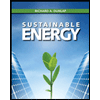
MindTap Engineering, 1 term (6 months) Printed Access Card for Dunlap's Sustainable Energy, SI Edition, 2nd
2nd Edition
ISBN: 9781337551779
Author: DUNLAP, Richard A.
Publisher: Cengage Learning
expand_more
expand_more
format_list_bulleted
Concept explainers
Question
Chapter 1, Problem 19P
To determine
Find the power plant’s rate of coal consumption.
Expert Solution & Answer
Trending nowThis is a popular solution!

Students have asked these similar questions
Design the deep beam in a wall for a warehouse, as shown in the drawing below using the strength
design method of TMS 402-22. The wall is to be constructed of fully grouted hollow concrete
masonry units in running bond. Determine the width of the masonry units, and the flexural and
shear reinforcement required. Use mf ′ = 2,000 psi and Grade 60 (60 ksi) steel, and Type S Portland
cement mortar. In addition to its own weight, it carries a dead load of 1.5 kip/ft. and a live load of
0.2 kip/ft. from the roof. The walls on both sides of the opening are very long. Therefore, you may
assume that the beam is fixed from rotation at both ends. Design using the following two methods.
(a) Design it as a deep beam with the moment arm z given by the code. Show the layout of the
flexural and shear reinforcements with diagrams.
(b) Design a masonry lintel beam (not a deep beam) that will carry the weight of the masonry of
above, and the dead and live loads from the roof. Determine whether you can…
Civil Engineering Question
6:31 mi
Official International Websit
maserati.com/global/en
Maserati
66
Continue without Accepting
Maserati
By clicking "Accept All Cookies", you agree to the storing
of cookies on your device to enhance site navigation,
analyze site usage, and assist in our marketing efforts.
Accept All Cookies
Cookies Settings
INTRODUCING THE ALL-NEW MASERATI
GranCabrio
DISCOVER MORE >
1/5
O
Chapter 1 Solutions
MindTap Engineering, 1 term (6 months) Printed Access Card for Dunlap's Sustainable Energy, SI Edition, 2nd
Knowledge Booster
Learn more about
Need a deep-dive on the concept behind this application? Look no further. Learn more about this topic, civil-engineering and related others by exploring similar questions and additional content below.Similar questions
- JOB UPDATE QUALCOMM FULL STACK DEVELOPER ASSOCIATE INFOR (FRESHERS) IBM QUALITY ENGINEER DATAVAIL DATABASE ADMINISTRATOR INTOUCH CUST SERVICE (CHAT/EMAIL) ACCENTURE Vinkjobs.com #vinkjobs CUSTOMER SUPPORT Search "Vinkjobs.com" on Googlearrow_forwardHello, I would like to ask if the answer provided in this link is correct based on the floor plan shown in the attached pictures? Kindly verify if the solution matches the actual layout and measurements. Thank you! https://www.bartleby.com/questions-and-answers/i-need-help-estimating-the-required-materials-for-masonry-works-using-chb-in-a-2-storey-residential-/bdb70948-ded3-4461-9057-f63a7a1c5f8farrow_forwardStructural analysis question Cleary explain each step with appropriate solviarrow_forward
- An activity on a non critical path has a total float of 16 days and a duration of 5 days. The start of the activity is delayed by delivery of material for 12 days. A worker shortage makes the activity take 12 days. How far behind the original critical path schedule are you? b.3 days a.0 days d.4 days c.4 days aheadarrow_forwardPlease answer the two questions in detail and as best as you can. Please ensure it is 100% done by human, please do not use AI or chatgpt.arrow_forwardPlease answer the two questions in detail and as best as you can. Please ensure it is 100% done by human, please do not use AI or chatgpt.arrow_forward
- Please answer the two questions in detail and as best as you can. Please ensure it is 100% done by human, please do not use AI or chatgpt.arrow_forwardPlease answer the two questions in detail and as best as you can. Please ensure it is 100% done by human, please do not use AI or chatgpt.arrow_forwardPlease answer the two questions in detail and as best as you can. Please ensure it is 100% done by human, please do not use AI or chatgpt.arrow_forward
- Please provide a handwritten solution to the questionarrow_forwardkevin.w.wickline@wv.govarrow_forwardWhat is the value of the influence line for the bending moment around B at B for the beam shown? Determine the influence line ordinates at 3-m intervals. Select the reaction at support C to be the redundant. A a. 1.875 kN 6 m b. 0.688 kN c. 2.25 kN > d. 0.313 KN B -12 m- El = constant Carrow_forward
arrow_back_ios
SEE MORE QUESTIONS
arrow_forward_ios
Recommended textbooks for you

 Sustainable EnergyCivil EngineeringISBN:9781133108689Author:Richard A. DunlapPublisher:Cengage Learning
Sustainable EnergyCivil EngineeringISBN:9781133108689Author:Richard A. DunlapPublisher:Cengage Learning Solid Waste EngineeringCivil EngineeringISBN:9781305635203Author:Worrell, William A.Publisher:Cengage Learning,
Solid Waste EngineeringCivil EngineeringISBN:9781305635203Author:Worrell, William A.Publisher:Cengage Learning, Engineering Fundamentals: An Introduction to Engi...Civil EngineeringISBN:9781305084766Author:Saeed MoaveniPublisher:Cengage Learning
Engineering Fundamentals: An Introduction to Engi...Civil EngineeringISBN:9781305084766Author:Saeed MoaveniPublisher:Cengage Learning


Sustainable Energy
Civil Engineering
ISBN:9781133108689
Author:Richard A. Dunlap
Publisher:Cengage Learning

Solid Waste Engineering
Civil Engineering
ISBN:9781305635203
Author:Worrell, William A.
Publisher:Cengage Learning,

Engineering Fundamentals: An Introduction to Engi...
Civil Engineering
ISBN:9781305084766
Author:Saeed Moaveni
Publisher:Cengage Learning